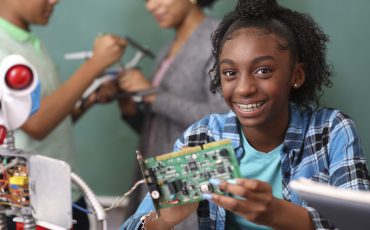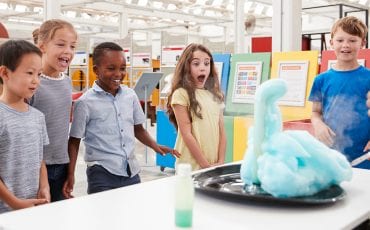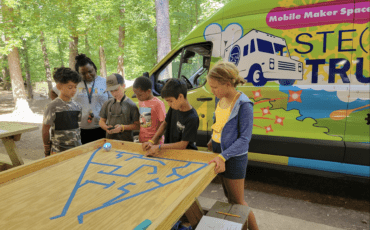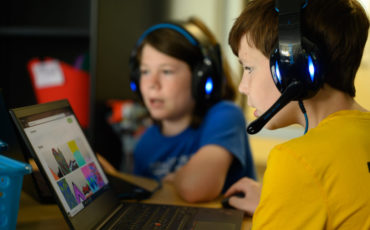Building a Love of STEAM
For years, STEAM (science, technology, engineering, arts and math) has played a large role in education, connecting various subjects through project-based learning, and building life-long skills like problem solving and collaboration. Developing a love of learning from a young age is easy and fun when you embrace STEAM.
Table of Contents
The Importance of STEAM
As education tries to address future needs, STEAM learning has become more prominent.
“The practical answer is STEAM education is important because we want kids to grow up and have careers that make money and make a difference in the world,” says Meisa Salaita, the co-founder of Science ATL. “The fun answer is science and the natural world are so inspiring. They make you feel a sense of awe about the world. Sparking curiosity at a young age gets kids to ask questions. If they know more, they have an ownership and care for the world, the human body, animals.”
Building Blocks
Inquiring into STEAM concepts from a young age will help your kids associate learning with joy.
Maureen Myrie, the founder of The STEAM Generation, exemplifies this. “As a little girl, I built computers with my dad. I chose computer science as my degree just because it had ‘computer’ in it. I had always known I wanted to do something with computers.”
Inspire interest in STEAM before your children attend school.
“Engaging children in hands-on, project-based and age-appropriate STEAM activities sparks curiosity,” Myrie says. “Simple experiments, interactive games, and visits to libraries and museums make learning fun. Weaving STEAM concepts into everyday conversations and connecting to real-world scenarios helps children see the relevance and excitement in these subjects.”
Once your children begin school, they will have a basis for classroom learning.
“STEAM learning can have immediate benefits to your child’s education because it is a project- based, interdisciplinary approach to learning,” says Evangeline Ricks Agbogu, Science Akadémeia’s director. “All five disciplines are integrated and applied in a creative approach to problem solving. This approach to learning develops critical thinking skills, fosters collaborative learning, improves communication, nurtures creativity and imagination and ignites a life-long love of learning and exploration.”
Looking Ahead
According to the U.S. Department of Labor Statistics, nearly 10 million people worked in STEAM occupations in 2021 and, by 2031, this total is projected to grow by almost 11%.
“As for the future, STEAM education puts your child on the pathway to both academic success and prepares them for future careers,” Agbogu says.
The world of STEAM is everchanging, but by helping kids develop a STEAM mindset, you’re prioritizing more than subject knowledge.
“STEAM is crucial because it nurtures a holistic skill set essential for the 21st century,” Myrie says. “STEAM education fosters creativity, critical thinking and problem solving — skills vital for future success. It prepares children not just for specific careers but empowers them with adaptability and the ability to approach challenges innovatively.”
The Importance of the Arts
There’s a popular misconception that people are either left-brained or right-brained. The theory suggests the left brain is more verbal, analytical and orderly, while the right brain is more visual, intuitive and creative; people tend to group themselves accordingly based on their interests. However, there is no research showing that this theory is correct. The two sides of the brain function differently, but they work together, as people don’t use only one side of their brain at a time.
This separate thinking can follow into education. “People think the subjects of STEAM are all in their own silo,” says Sharon Duke Estroff, the founder and CEO of Challenge Island. “But when you think of STEAM as an all-encompassing mindset, there are opportunities to teach everywhere. It’s the mindset of how you approach the world. Kids are born creative, and creativity gives you the freedom to apply STEAM to everything.”
To prevent your family from falling into the trap of separate thinking, Salaita suggests finding themes and projects that cross the disciplines. “There’s a lot of creativity in writing, and there’s a lot of creativity in science to solve the questions of today. You can’t do the same things over and over again. Creativity is important in every aspect of learning.”
Screen Time
A possible fear you might have with incorporating STEAM with young kids is that it will lead to even more screen time. The American Academy of Pediatrics recommends limiting school-aged children’s screen time to no more than two hours a day.
“The idea that technology has to be digital technology is a mistake. Technology is just a new solution to a problem,” Estroff says. One of Challenge Island’s pillars is “Screen Free Fun,” as kids turn off their devices and connect with their peers. “The wheel was technology — it was something new. Every time you solve a problem, you’re creating technology, and when you add the aesthetics to it, you’ve got STEAM.”
If you give your children materials, you will be surprised by their ability to innovate without needing to increase their time on devices.
Developing Soft Skills
Because of the importance of STEAM careers and the higher-paying jobs associated with this mindset, parents may be tempted to pressure their kids onto certain paths.
“One of the mistakes people make with STEAM is they think of it like magic. They think, ‘If I expose my kids to STEAM, they’ll be a CEO of Google; they’ll go to Harvard.’ That’s like making a cake with only flour. There’s other pieces to know, so they’ll be able to use their knowledge,” Estroff says. “You’ll need soft skills, too: flexibility, leadership, the ability to listen to others’ ideas, resilience.”
STEAM learning should incorporate soft skills with subject mastery.
“One way to think about STEAM is it’s everything you can’t test on standardized tests. Take the approach that your kids aren’t getting soft skills at school,” Estroff recommends. “They’re already doing all the school stuff, so with you, give them the other pieces — problem solving, social skills, flexible thinking. Think about the characteristics you want your kid to have.”
The STEAM Generation views STEAM as a team sport. “In group projects, children learn to express ideas, listen to others and solve problems collectively, emphasizing collaboration, communication and creativity,” Myrie says. “These experiences build social and emotional skills, teaching not only the subjects, but also teamwork, empathy and resilience — qualities crucial in all aspects of life.”
It’s not a bad idea to think ahead, but make sure your kids are having fun. “Our job is to prepare kids for jobs that haven’t yet been invented,” Estroff says. “Let your kids lead the way rather than forcing it on them.”
Drop the Grades
Thinking about incorporating education into your family life may take you back to your own classroom days, where you might have loved STEAM. Or you might have hated it. If you approach STEAM learning at home the same as at school, you and your children will feel unmotivated to explore.
“The key is to present STEAM as a natural part of life, sparking curiosity beyond the classroom,” Myrie says.
Cater to your child’s interests. If they love the outdoors, on your next family walk, pay more attention to your surroundings and ask questions about what’s blooming and why. If your child loves shopping, use discounts to teach them how to calculate percentages.
“Parents feel so much pressure thinking their kids are already behind,” Estroff says. “Let go of that. Parents need to let their kids guide them.”
Schoolwork can be very intimidating, but creating an at-home learning environment doesn’t need to feel like school.
“Science learning is associated with in-classroom learning, which comes with tests, hard questions and pressure. It takes away natural curiosity because of the tasks associated with it,” Salaita says. “Science doesn’t have to be for you as a career, but it’ll be a part of your life in whatever you do. Having an exposure to science outside of the classroom reminds you of the wonder of science.”
As a parent, if you don’t feel like you are particularly skilled in STEAM, dropping the classroom mindset can free you to have fun with your child.
“Kids are natural scientists; they are curious about the world around them. It is important to nurture that natural curiosity to foster their love of science and learn about their environment and how things work,” Agbogu says. “Bring back your own childhood curiosity. Remember when you were a kid, and the world was an interesting and fascinating place to discover? Go on a journey of discovery with your child.”
Admit when you don’t know the answer.
“As the parent, we feel we have to know the answers. But science is all about not knowing. We don’t know so much, and science is a process about figuring it out,” says Salaita. “If they have a sense of curiosity about something, figure it out and explore together.”
Change your mindset about learning.
“Parents can make a big difference in their child’s approach to learning science if they take away the intimidation factor and approach it as a journey of discovery for both parent and child,” Agbogu says. “Taking this journey of exploration with your child and learning together can create an opportunity to bond with your child and have a positive influence, cultivating the love of life-long learning which will make an impact on the entire family.”










